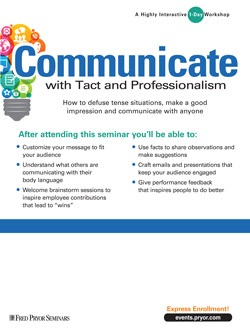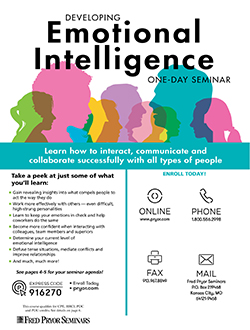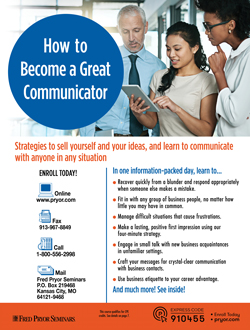Dealing With a Rude or Aggressive Customer
Many people have struggled over the past two years. Lives have become increasingly unpredictable – with uncertainty about jobs, the economy, health and school. Many people have also experienced some form of loss during this time – personal, professional and social. The result has been an uptick in aggressive and rude customer behavior, as people bring their frustration and anger into businesses and workplaces.
In this article, we talk about how to recognize an aggressive customer, how to manage your own reaction and how to handle volatile situations. We also touch on how to recover after a particularly difficult interaction.
Recognizing an Aggressive Customer
We all want to feel a sense of peace and safety at work; however, it is also important to stay attentive to what’s happening around us. Here are some ways to recognize a potentially aggressive or rude customer early. Stay attentive to the person who:
- Shows impatience through body language and facial expressions.
- Interrupts those who offer to help or ask a question.
- Talks out loud to no one in particular, complaining about something.
- Is aggressive with those they are with – such as talking angrily to a child or partner.
You then need to decide whether to intervene. Sometimes, a person just needs some space to process their own experience. Emotions are temporary and a natural shift in emotions may lead to a shift in behavior. Sometimes, a smile and open face can help spark empathy in the person and cause them to calm down and recenter. And sometimes, people are just mad and need some way to express that. A little observation and assessment at the start of a conversation can go a long way in helping you anticipate what might happen next.
Emotional Intelligence (or EQ) can help you in recognizing a rude or aggressive customer before you get deep into a conversation. In Pryor’s Developing Emotional Intelligence seminar, we review the importance of both self-awareness and social competency – helping you better read yourself and others. This can make a big difference in diffusing aggressiveness.
Managing Your Own Reaction
When someone is upset, it is easy to slip into “fight or flight” mode – you may want to rise to the challenge or simply exit the situation. Here are five simple steps you can take in the moment to better manage yourself and decide what to do.
- Take a deep breath – or three! Slow but natural breaths will help your own brain from getting hijacked by your own emotions. This also gives you the mental space to think through what might happen next, helping you enter and activate your problem-solving skills.
- Think of three strengths that you have in approaching the situation. This can help build your own self-awareness and confidence in managing your way through whatever happens next. For example, you may be proud of your knowledge about the organization’s offerings; you may know you are a good listener; and you may describe yourself as quick-on-your-feet. All of these can be helpful in preparing for an aggressive customer.
- Know your own triggers and response options. When we pause and think about it, most of us know what pushes our buttons – what causes us to react negatively to a negative or scary situation or person. Knowing those triggers can help us prepare to respond. For example: “I know I am a people pleaser and that when someone is disappointed, I will often feel like I did something wrong.” You might counter this with: “Therefore, I will be careful to remember that I am OK, and while I may be able to help here, this person’s problem is likely not my fault.”
- Find empathy wherever you can. Most of the time while you may be the focus of someone’s anger, it is not about you – and is often not even about the situation. There is very likely something happening with the other person that is causing pain which can lead to anger. Remembering that you can never really know what is happening with another person can help you find empathy for whatever they are experiencing or going through in that moment.
- Know and assess your environment. Your own safety and the safety of others is paramount. When approaching someone else place yourself in a way that allows you to walk away easily if needed. (For those responsible for or working in an office environment, Pryor’s Front Desk Safety & Security seminar gives important concrete tips for your organization.)
Taking care of yourself helps you approach someone else in the best way possible. Now, let’s turn to the next step – concrete ways to handle aggressive or volatile situations.
Ways to Handle Volatile Situations
With the general increase in customer volatility, it’s important to be able to diffuse difficult situations. Here are concrete ways to handle an aggressive customer.
- Approach with a gentle smile. Too much cheeriness can make someone even angrier! Don’t overdo anything – use small body movements and an open face and demeanor. Pryor’s downloadable How to Read Body Language in 10 Seconds Flat can help you read others more easily in a wide range of situations.
- Have a standard opening and some open-ended questions. Saying hello and introducing yourself reminds the other person that you are human too. Open ended questions can help you ease into a conversation and allow you to focus on the other person. “What are you looking for today?” or “May I help?” are easy ways to start.
- Actively engage. People need feedback and engagement. When we only listen, it can be misinterpreted as disconnectedness or a lack of caring. Given this, try to acknowledge comments with both voice and body movements. Voicing understanding and openness is even more important if the interaction is on the phone. Pryor’s pre-recorded webinar, Active Listening Skills to Improve Communication, provides valuable tips for improving your communication skills through active listening.
- Provide options. Often, people who are angry or who are afraid need to feel a sense of power or control in their lives. Giving them options – and not telling them what they should do – gives them the ability to make their own choices. Once they feel they have more control, it may be easier to de-escalate the situation. This may be different options for products and services, or different options for how to learn more or how to proceed. Letting the customer manage their experience can help diffuse a situation.
- Have an exit strategy. If the situation devolves or feels unsafe know what to do next. This could include calling a colleague for support, gently noting that you have done what you can to help, quietly indicating that the person needs to leave or walking away to a safer distance and alerting management.
- Know your company’s policies. Your approach and exit strategy should be informed by your company’s customer service policies. It is important to note what your organization defines as acceptable customer behavior and what is over the line of acceptability. If your organization does not have these policies or guidelines, consider talking with your supervisor to get feedback about how they would generally prefer that you handle different scenarios. This is also important in protecting you if things go poorly in an interaction.
Recovering from an Aggressive Interaction
Dealing with an aggressive or rude customer can leave you drained and on edge yourself! It’s important not to take that out on colleagues, friends, family or other customers. Here are some recovery tips:
- Just like you did before the interaction, take a deep breath or three! This will help your brain and body start to move out of fight-or-flight mode.
- For a particularly volatile interaction, alert your supervisor to what happened – this helps leadership see patterns over time so they can better plan staffing, back-up procedures and policies. It also helps your boss understand any different needs you may have to adjust after the event.
- Ask for a quick break to take a walk for some air – even just walking through the parking lot gives you a brief change of scenery for a reset.
- Briefly debrief with a colleague to process what happened. Pick someone who you believe will best fit your needs in that moment – be it a hug, pep talk or just a friendly smile and ear.
- Periodically assess the frequency of aggressive events and consider the cost they have on you – if you ask for additional support, your workplace does not address the situation and you regularly feel unsaf consider exploring other options.
Pryor has a full range of offerings to help you prepare for and handle aggressive and rude customers with more ease – while also helping you build relationships with colleagues. The seminar Dealing with Difficult People, for example, provides lots of strategies, tips and techniques for fighting frustration in the workplace. Mastering Communication Skills with Tact and Confidence will help you develop the inter-personal skills needed to engage with both customers and colleagues with confidence.










